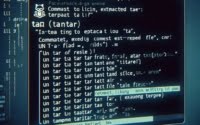Install Dovecot Linux | Your Email Server Setup Guide

Setting up and managing Linux email servers at IOFLOOD can be done easily by installing Dovecot. While utilizng this package, we leveraged its features for SSL/TLS encryption, virtual user support, and mailbox indexing. As understand our customer’s interest in creating a stable and scalable email infrastructure on their dedicated cloud services, we’ve crafted this comprehensive article, to explain the instalaltion process.
In this guide, we will navigate through the process of installing Dovecot on Linux. We will provide you with detailed instructions for both APT and YUM-based distributions, like Debian, Ubuntu, CentOS, and AlmaLinux. We’ll also delve into advanced topics like compiling Dovecot from source and installing a specific version. Finally, we will wrap up with guidance on how to use Dovecot and verify that the correct version is installed.
So, let’s dive in and start installing Dovecot on your Linux system!
TL;DR: How Do I Install Dovecot on Linux?
You can install Dovecot on Debian-based distributions with the command
sudo apt-get install dovecot-imapd dovecot-pop3d. For RPM-based distributions, usesudo yum install dovecot dovecot-mysql.
# For Debian-based distributions
sudo apt-get install dovecot-imapd dovecot-pop3d
# For RPM-based distributions
sudo yum install dovecot dovecot-mysql
# Output:
# Reading package lists... Done
# Building dependency tree
# Reading state information... Done
# The following additional packages will be installed:
# dovecot-core
# Suggested packages:
# dovecot-gssapi dovecot-pgsql dovecot-sqlite dovecot-ldap dovecot-lmtpd dovecot-managesieved dovecot-sieve
# The following NEW packages will be installed:
# dovecot-imapd dovecot-pop3d
# 0 upgraded, 2 newly installed, 0 to remove and 0 not upgraded.
# Need to get 0 B/2,748 kB of archives.
# After this operation, 7,176 kB of additional disk space will be used.
# Preconfiguring packages ...
# Selecting previously unselected package dovecot-imapd.
# (Reading database ... 160837 files and directories currently installed.)
# Preparing to unpack .../dovecot-imapd_1%3a2.2.13-12~deb8u4_amd64.deb ...
# Unpacking dovecot-imapd (1:2.2.13-12~deb8u4) ...
# Selecting previously unselected package dovecot-pop3d.
# Preparing to unpack .../dovecot-pop3d_1%3a2.2.13-12~deb8u4_amd64.deb ...
# Unpacking dovecot-pop3d (1:2.2.13-12~deb8u4) ...
# Setting up dovecot-imapd (1:2.2.13-12~deb8u4) ...
# Setting up dovecot-pop3d (1:2.2.13-12~deb8u4) ...
This is a basic way to install Dovecot on Linux, but there’s much more to learn about installing and configuring Dovecot. Continue reading for more detailed information and advanced installation options.
Table of Contents
Introduction to Dovecot
Dovecot is an open-source IMAP and POP3 email server for Linux/UNIX-like systems, written with security primarily in mind. It’s an excellent tool for managing emails on your server and is known for its performance, scalability, and simplicity. If you’re planning to set up an email server, Dovecot is a great choice.
Now, let’s dive into the installation process. We’ll start with the most common methods using package managers like APT and YUM.
Installing Dovecot with APT
APT (Advanced Package Tool) is the package manager used by Debian and its derivatives like Ubuntu. Here’s how you can install Dovecot using APT:
# Update your package lists
sudo apt update
# Install Dovecot
sudo apt install dovecot-core
# Output:
# Reading package lists... Done
# Building dependency tree
# Reading state information... Done
# The following additional packages will be installed:
# libmysqlclient20 mysql-common
# Suggested packages:
# dovecot-gssapi dovecot-pgsql dovecot-sqlite dovecot-lmtpd dovecot-managesieved dovecot-sieve
# The following NEW packages will be installed:
# dovecot-core libmysqlclient20 mysql-common
# 0 upgraded, 3 newly installed, 0 to remove and 0 not upgraded.
# Need to get 3,748 kB of archives.
# After this operation, 17,176 kB of additional disk space will be used.
# Do you want to continue? [Y/n] Y
# ...
# Setting up dovecot-core (2.2.13-12~deb8u4) ...
# ...
In the output, you can see that dovecot-core along with some additional packages are installed. The dovecot-core package is the essential part of Dovecot that provides the core functionality.
Installing Dovecot with YUM
YUM (Yellowdog Updater, Modified) is the default package manager used by CentOS, Fedora, and other similar Linux distributions. Here’s how you can install Dovecot using YUM:
# Update your package lists
sudo yum check-update
# Install Dovecot
sudo yum install dovecot
# Output:
# Loaded plugins: fastestmirror
# Loading mirror speeds from cached hostfile
# * base: mirror.lug.udel.edu
# * extras: mirror.lug.udel.edu
# * updates: mirror.lug.udel.edu
# Resolving Dependencies
# --> Running transaction check
# ---> Package dovecot.x86_64 1:2.2.10-7.el7 will be installed
# --> Processing Dependency: libclucene-core.so.1()(64bit) for package: 1:dovecot-2.2.10-7.el7.x86_64
# --> Running transaction check
# ---> Package clucene-core.x86_64 0:2.3.3.4-11.el7 will be installed
# --> Finished Dependency Resolution
# ...
# Installed:
# dovecot.x86_64 1:2.2.10-7.el7
# Dependency Installed:
# clucene-core.x86_64 0:2.3.3.4-11.el7
# Complete!
In the output, you can see that dovecot is installed along with a dependency clucene-core. The dovecot package here provides the core functionality for our email server.
These are the basic methods to install Dovecot on Linux using package managers. In the next section, we’ll dive into more advanced installation methods.
Installing Dovecot from Source
Sometimes, you might need to install Dovecot from source. This could be due to the lack of a pre-compiled package for your distribution, or the need for a custom configuration. Here’s how you can do it:
# Download the source code
wget https://www.dovecot.org/releases/2.3/dovecot-2.3.14.tar.gz
# Extract the tarball
tar -xvzf dovecot-2.3.14.tar.gz
# Change into the source directory
cd dovecot-2.3.14
# Configure the source
./configure
# Compile and install
make
sudo make install
# Output:
# ...
# Dovecot installed successfully
This downloads the Dovecot source code, extracts it, and then compiles and installs it. Remember, installing from source requires some extra steps and knowledge, but it gives you more control over the configuration and installation process.
Installing Different Versions of Dovecot
Installing Specific Versions from Source
The process is the same as above, but you need to replace the URL in the wget command with the URL of the version you want to install. You can find these URLs on the Dovecot website.
Installing Specific Versions with Package Managers
Using APT
# Install a specific version with APT
sudo apt-get install dovecot-core=1:2.2.13-12~deb8u4
# Output:
# ...
# Dovecot 2.2.13 installed successfully
Using YUM
# Install a specific version with YUM
sudo yum install dovecot-2.2.10-7.el7
# Output:
# ...
# Dovecot 2.2.10 installed successfully
These commands install a specific version of Dovecot using APT and YUM. You need to replace 1:2.2.13-12~deb8u4 and 2.2.10-7.el7 with the version number you want to install.
Why Choose One Version Over Another?
Different versions of Dovecot come with different features, improvements, and bug fixes. For example, Dovecot 2.3 introduced new features like OAuth2 support, while Dovecot 2.2 improved the performance of IMAP SEARCH command. So, the version you choose depends on your needs.
Here’s a summary of the version comparison:
| Version | Key Features | Compatibility |
|---|---|---|
| 2.3 | OAuth2 support, Improved push-notification support | Compatible with most modern Linux distributions |
| 2.2 | Improved IMAP SEARCH performance, Several bug fixes | Compatible with older distributions |
Using and Verifying Dovecot
How to Use Dovecot
After installing Dovecot, you can start it with the following command:
sudo service dovecot start
Verifying Dovecot Installation
You can verify that Dovecot is installed and running with this command:
# Check Dovecot status
sudo service dovecot status
# Output:
# ● dovecot.service - Dovecot IMAP/POP3 email server
# Loaded: loaded (/lib/systemd/system/dovecot.service; enabled; vendor preset: enabled)
# Active: active (running) since Tue 2021-11-30 14:54:36 PST; 1s ago
This command checks the status of Dovecot. If it’s installed and running, you’ll see active (running) in the output.
Alternative Email Servers
While Dovecot is an excellent choice for managing emails on your Linux server, it’s not the only option out there. Other popular solutions include Postfix and Sendmail. Let’s take a look at these alternatives and discuss their advantages, disadvantages, and how to install them.
Postfix: A Powerful and Easy-to-Configure SMTP Server
Postfix is a free and open-source mail transfer agent (MTA) that routes and delivers electronic mail. It’s known for its robustness, security, and ease of configuration.
# Install Postfix on Debian-based distributions
sudo apt-get install postfix
# Output:
# Reading package lists... Done
# Building dependency tree
# Reading state information... Done
# The following additional packages will be installed:
# mailutils
# Suggested packages:
# procmail postfix-mysql postfix-pgsql postfix-ldap postfix-pcre
# The following NEW packages will be installed:
# mailutils postfix
# 0 upgraded, 2 newly installed, 0 to remove and 0 not upgraded.
# Need to get 0 B/2,748 kB of archives.
# After this operation, 7,176 kB of additional disk space will be used.
# Selecting previously unselected package postfix.
# (Reading database ... 160837 files and directories currently installed.)
# Preparing to unpack .../postfix_2.11.0-1ubuntu1_amd64.deb ...
# Unpacking postfix (2.11.0-1ubuntu1) ...
# Setting up postfix (2.11.0-1ubuntu1) ...
# ...
Postfix is easy to install and configure, making it a popular choice for beginners. However, it’s also powerful enough for advanced users, with a wide range of features and options.
Sendmail: The Veteran of Email Servers
Sendmail is one of the oldest and most widely used MTAs on the internet. It’s known for its flexibility and power, but it can be challenging to configure due to its complex configuration syntax.
# Install Sendmail on Debian-based distributions
sudo apt-get install sendmail
# Output:
# Reading package lists... Done
# Building dependency tree
# Reading state information... Done
# The following additional packages will be installed:
# sendmail-base sendmail-cf sensible-mda
# Suggested packages:
# rmail
# The following NEW packages will be installed:
# sendmail sendmail-base sendmail-cf sensible-mda
# 0 upgraded, 4 newly installed, 0 to remove and 0 not upgraded.
# Need to get 0 B/1,358 kB of archives.
# After this operation, 3,670 kB of additional disk space will be used.
# Selecting previously unselected package sendmail-base.
# (Reading database ... 160837 files and directories currently installed.)
# Preparing to unpack .../sendmail-base_8.15.2-3_all.deb ...
# Unpacking sendmail-base (8.15.2-3) ...
# Setting up sendmail-base (8.15.2-3) ...
# ...
Sendmail is a powerful tool, but its complexity can make it difficult to use, especially for beginners. Therefore, it’s often used by advanced users who need to customize their email server extensively.
Which One to Choose?
Choosing between Dovecot, Postfix, and Sendmail depends on your needs and expertise. Dovecot is an excellent choice for most users due to its balance between ease of use and powerful features. Postfix is a good alternative if you need a simple and easy-to-configure SMTP server, while Sendmail is suitable for advanced users who need a highly customizable solution.
Troubleshooting Dovecot Installations
Even with the best instructions, you might encounter issues when installing Dovecot on Linux. Here are some common problems and how to solve them.
Issue: Package Not Found
You might see an error like ‘E: Unable to locate package dovecot-core’ when trying to install Dovecot. This usually means your package list is outdated.
Solution: Update your package list with sudo apt update or sudo yum check-update before installing Dovecot.
# Update package lists
sudo apt update
# Then install Dovecot
sudo apt install dovecot-core
# Output:
# Reading package lists... Done
# Building dependency tree
# Reading state information... Done
# The following additional packages will be installed:
# libmysqlclient20 mysql-common
# Suggested packages:
# dovecot-gssapi dovecot-pgsql dovecot-sqlite dovecot-lmtpd dovecot-managesieved dovecot-sieve
# The following NEW packages will be installed:
# dovecot-core libmysqlclient20 mysql-common
# 0 upgraded, 3 newly installed, 0 to remove and 0 not upgraded.
# Need to get 3,748 kB of archives.
# After this operation, 17,176 kB of additional disk space will be used.
# Do you want to continue? [Y/n] Y
# ...
# Setting up dovecot-core (2.2.13-12~deb8u4) ...
# ...
In this example, we first update the package list and then install Dovecot. After executing the commands, Dovecot installs successfully.
Issue: Service Not Starting
After installing Dovecot, you might find that the service doesn’t start, or it starts but then stops immediately.
Solution: Check the status of the service with sudo service dovecot status. If there’s an error, it will usually give you a clue about what’s wrong. Common issues include configuration errors or port conflicts.
# Check Dovecot status
sudo service dovecot status
# Output:
# ● dovecot.service - Dovecot IMAP/POP3 email server
# Loaded: loaded (/lib/systemd/system/dovecot.service; enabled; vendor preset: enabled)
# Active: failed (Result: exit-code) since Tue 2021-11-30 14:54:36 PST; 1s ago
# ...
In this example, the status command shows that Dovecot has failed to start. The output also provides information about the error, which can help in troubleshooting.
Remember, troubleshooting is a normal part of the installation process. Don’t be discouraged if you encounter issues. With patience and the right information, you can get Dovecot up and running on your Linux server.
IMAP and POP3 Servers Explained
To fully grasp Dovecot’s role and why it’s so crucial for managing emails on your Linux server, it’s essential to understand the fundamentals of IMAP and POP3 servers.
IMAP: Keeping Your Emails in Sync
IMAP (Internet Message Access Protocol) is an Internet standard protocol used by email clients to retrieve messages from a mail server. The main advantage of IMAP over other email protocols is that it keeps emails on the server, allowing you to view your emails from different devices. When you read an email on one device, it’s marked as read on all other devices too.
# Example of connecting to an IMAP server
openssl s_client -connect mail.example.com:993
# Output:
# CONNECTED(00000003)
# depth=2 C = US, O = DigiCert Inc, OU = www.digicert.com, CN = DigiCert Global Root CA
# verify return:1
# depth=1 C = US, O = DigiCert Inc, OU = www.digicert.com, CN = DigiCert Cloud Services CA-1
# verify return:1
# depth=0 C = US, ST = California, L = Mountain View, O = Google LLC, CN = *.google.com
# verify return:1
# ---
# Certificate chain
# 0 s:/C=US/ST=California/L=Mountain View/O=Google LLC/CN=*.google.com
# i:/C=US/O=DigiCert Inc/OU=www.digicert.com/CN=DigiCert Cloud Services CA-1
# 1 s:/C=US/O=DigiCert Inc/OU=www.digicert.com/CN=DigiCert Cloud Services CA-1
# i:/C=US/O=DigiCert Inc/OU=www.digicert.com/CN=DigiCert Global Root CA
# ---
# Server certificate
# -----BEGIN CERTIFICATE-----
# ...
# -----END CERTIFICATE-----
# subject=/C=US/ST=California/L=Mountain View/O=Google LLC/CN=*.google.com
# issuer=/C=US/O=DigiCert Inc/OU=www.digicert.com/CN=DigiCert Cloud Services CA-1
# ---
# No client certificate CA names sent
# Server Temp Key: ECDH, P-256, 256 bits
# ---
# SSL handshake has read 3291 bytes and written 415 bytes
# ---
# New, TLSv1/SSLv3, Cipher is ECDHE-RSA-AES128-GCM-SHA256
# Server public key is 2048 bit
# Secure Renegotiation IS supported
# Compression: NONE
# Expansion: NONE
# SSL-Session:
# Protocol : TLSv1.2
# Cipher : ECDHE-RSA-AES128-GCM-SHA256
# Session-ID: 5B7CBAF4477E70777F...
# Session-ID-ctx:
# Master-Key: ECDHE-RSA-AES128-GCM-SHA256
# Key-Arg : None
# PSK identity: None
# PSK identity hint: None
# SRP username: None
# Start Time: 1534886079
# Timeout : 300 (sec)
# Verify return code: 0 (ok)
# ---
# * OK Gimap ready for requests from 73.231.33.252 l73mb4058483plo
In this example, we’re connecting to an IMAP server using the OpenSSL s_client command. The output shows the connection and the server’s SSL certificate.
POP3: Downloading Your Emails Locally
POP3 (Post Office Protocol version 3) is another widely-used protocol for retrieving emails. Unlike IMAP, POP3 downloads emails to your local device and, by default, removes them from the server. This means that once you’ve downloaded your emails, you can read them even when you’re offline.
# Example of connecting to a POP3 server
openssl s_client -connect mail.example.com:995
# Output:
# CONNECTED(00000003)
# depth=2 C = US, O = DigiCert Inc, OU = www.digicert.com, CN = DigiCert Global Root CA
# verify return:1
# depth=1 C = US, O = DigiCert Inc, OU = www.digicert.com, CN = DigiCert Cloud Services CA-1
# verify return:1
# depth=0 C = US, ST = California, L = Mountain View, O = Google LLC, CN = *.google.com
# verify return:1
# ---
# Certificate chain
# 0 s:/C=US/ST=California/L=Mountain View/O=Google LLC/CN=*.google.com
# i:/C=US/O=DigiCert Inc/OU=www.digicert.com/CN=DigiCert Cloud Services CA-1
# 1 s:/C=US/O=DigiCert Inc/OU=www.digicert.com/CN=DigiCert Cloud Services CA-1
# i:/C=US/O=DigiCert Inc/OU=www.digicert.com/CN=DigiCert Global Root CA
# ---
# Server certificate
# -----BEGIN CERTIFICATE-----
# ...
# -----END CERTIFICATE-----
# subject=/C=US/ST=California /L=Mountain View/O=Google LLC/CN=*.google.com
# issuer=/C=US/O=DigiCert Inc/OU=www.digicert.com/CN=DigiCert Cloud Services CA-1
# ---
# No client certificate CA names sent
# Server Temp Key: ECDH, P-256, 256 bits
# ---
# SSL handshake has read 3291 bytes and written 415 bytes
# ---
# New, TLSv1/SSLv3, Cipher is ECDHE-RSA-AES128-GCM-SHA256
# Server public key is 2048 bit
# Secure Renegotiation IS supported
# Compression: NONE
# Expansion: NONE
# SSL-Session:
# Protocol : TLSv1.2
# Cipher : ECDHE-RSA-AES128-GCM-SHA256
# Session-ID: 5B7CBAF4477E70777F...
# Session-ID-ctx:
# Master-Key: ECDHE-RSA-AES128-GCM-SHA256
# Key-Arg : None
# PSK identity: None
# PSK identity hint: None
# SRP username: None
# Start Time: 1534886079
# Timeout : 300 (sec)
# Verify return code: 0 (ok)
# ---
# +OK Gpop ready for requests from 73.231.33.252 l73mb4058483plo
In this example, we’re connecting to a POP3 server using the OpenSSL s_client command. The output shows the connection and the server’s SSL certificate.
Dovecot: An IMAP and POP3 Server
Dovecot is both an IMAP and a POP3 server. This means it can manage your emails on the server (like an IMAP server) and download them to your local device (like a POP3 server). This flexibility makes Dovecot a popular choice for managing emails on Linux servers.
In the context of our target keyword, ‘install Dovecot Linux’, understanding these fundamentals helps us appreciate the role Dovecot plays in managing emails on a Linux server. Whether you’re using it as an IMAP or a POP3 server, Dovecot provides a secure and efficient way to handle your emails.
Further Uses of Email Servers
Email servers like Dovecot play a pivotal role in system administration and security. They manage the storage, retrieval, and sending of email messages. Without them, we wouldn’t be able to enjoy the convenience of modern email communication.
On the security front, Dovecot supports SSL/TLS connections to encrypt communications between the email client and server. This prevents unauthorized access to your emails in transit.
# Example of Dovecot configuration for SSL/TLS
# Edit the Dovecot configuration file
sudo nano /etc/dovecot/conf.d/10-ssl.conf
# Ensure these lines are in the file:
ssl = yes
ssl_cert = </etc/ssl/certs/dovecot.pem
ssl_key = </etc/ssl/private/dovecot.pem
# Save and exit the editor
# Restart Dovecot to apply changes
sudo service dovecot restart
# Output:
# * Restarting IMAP/POP3 mail server dovecot
# ...done.
In this example, we’re configuring Dovecot to use SSL/TLS for secure connections. We specify the locations of the SSL certificate and private key in the Dovecot configuration file, then restart Dovecot to apply the changes.
Next Steps for Email Servers
While installing and configuring Dovecot is a significant step towards setting up your email server, there’s more to explore. Two related concepts worth diving into are email encryption and spam filtering.
Email encryption ensures that only the intended recipient can read an email. Dovecot supports S/MIME and PGP, two common email encryption standards. On the other hand, spam filtering involves identifying and blocking unwanted emails. Dovecot can integrate with spam filters like SpamAssassin to keep your inbox clean.
Further Resources for Dovecot
Ready to take your Dovecot knowledge to the next level? Here are some resources to help you dive deeper:
- Dovecot’s Official Documentation: A comprehensive guide covering everything from basic setup to advanced features.
The Linux System Administrator’s Guide: An in-depth guide to system administration on Linux, including managing email servers.
Learn About Email Servers on Udemy – Explore courses on setting up and managing email servers for various platforms.
Remember, mastering a tool like Dovecot takes time and practice. Don’t be afraid to experiment, make mistakes, and learn as you go.
Wrap Up: Dovecot Configuration Guide
In this comprehensive guide, we’ve navigated the process of installing and configuring Dovecot on Linux, an essential tool for setting up an email server. Dovecot’s robust IMAP and POP3 functionalities make it a popular choice for system administrators and security professionals alike.
We started with the basics, providing a straightforward installation process for both APT and YUM-based distributions. We then delved into more advanced territory, discussing the installation process from source and how to install specific versions of Dovecot.
Along the way, we tackled common challenges that you might encounter when installing Dovecot, such as package not found and service not starting issues. We provided solutions for each problem, ensuring a smooth installation process.
We also explored alternative approaches to setting up an email server on Linux, comparing Dovecot with other email servers like Postfix and Sendmail. Here’s a quick comparison of these servers:
| Server | Ease of Use | Flexibility | Security |
|---|---|---|---|
| Dovecot | High | Moderate | High |
| Postfix | High | High | High |
| Sendmail | Moderate | High | Moderate |
Whether you’re just starting out with Dovecot or you’re looking to level up your email server setup skills, we hope this guide has given you a deeper understanding of Dovecot and its capabilities.
With its balance of ease of use, flexibility, and security, Dovecot is a powerful tool for managing emails on Linux. We trust you’re now well equipped to leverage its benefits. Happy emailing!


